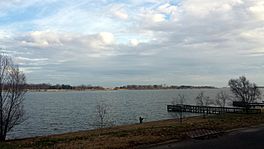Lake Chicot facts for kids
Quick facts for kids Lake Chicot |
|
|---|---|

Lake Chicot from Lake Village, Arkansas
|
|
| Location | Chicot County, Arkansas |
| Coordinates | 33°19′21″N 91°16′42″W / 33.32250°N 91.27833°W |
| Type | Oxbow lake |
| Basin countries | United States |
| Surface elevation | 105 ft (32 m) |
Lake Chicot is a special lake next to the Mississippi River in Arkansas. You can find it on the east side of Lake Village, in Chicot County. It's the biggest oxbow lake in North America. An oxbow lake is a U-shaped lake that forms when a wide bend of a river is cut off from the main river. Lake Chicot is also the largest natural lake in Arkansas. It was formed about 300 years ago when the Mississippi River changed its path.
The name Chicot comes from a French word meaning "stumpy." This name refers to the many cypress tree stumps and trees found along the lake's edges. The lake is about 0.75 miles (1.2 km) wide. It stretches for about 21 to 22 miles (34 to 35 km) from one end to the other. If you look at it from above, it forms a big "C" shape.
The Arkansas Department of Parks and Tourism manages Lake Chicot State Park. This park is located at the northern end of the lake. Chicot County also has a county park. This park is on the eastern side of the lake, right across from Lake Village. At the State Park, you can find a bait shop, a place to clean fish, and a fishing pier. The bait shop also rents out boats. The visitors' center at the state park offers cabins for rent and places to camp. There's even a wildlife museum there. It shows off animals that live in and around Lake Chicot.
Contents
Fun Things to Do at Lake Chicot
Fishing Adventures
In 1968, a big project started to help Lake Chicot. The Arkansas Game and Fish Commission, the United States Army Corps of Engineers, and the Chicot County Rural Development Authority worked together. They wanted to make the lake healthy again. Back in 1927, a flood damaged a dam. This caused a lot of mud and dirt to flow into the southern part of the lake. This pollution harmed the fish, especially the bass.
The upper part of the lake was safe because a dam protected it. So, the groups decided to drain the polluted southern section. This helped to press down the mud at the bottom. Then, they planted special vegetation to create a good home for fish. The southern part of Lake Chicot was restocked with fish. Now, it is a thriving place for many kinds of fish. You can catch fish like Bluegills, channel catfish, and largemouth bass. Other fish include hybrid striper bass, crappie, redear sunfish, and bream.
Boating on the Lake
Lake Chicot State Park has a great marina where you can launch your boat. The park is on the northern part of the lake. If you don't have your own boat, you can rent one there. They offer 15-foot bass boats with a 9.9 HP motor. You can also find fishing and camping gear at the State Park's store. Other popular places to launch boats are Jack R. Rhodes Lake Front Park in downtown Lake Village and the Chicot County Park.
Exploring Lake Chicot State Park
Lake Chicot State Park offers 122 campsites and 14 cabins. It's a great place for large groups to gather, with indoor pavilions available. The park is located right in the path of the Mississippi Flyway. This means it's an amazing spot for watching birds. Many different kinds of birds fly through this area.
Hiking is another fun activity at the park. The Delta Woodlands Trail is 1 mile (1.6 km) long. It's an easy trail, perfect for a relaxed walk. The trail is surrounded by bottomland hardwood trees. You might see squirrels playing in the pecan trees along the path. Birds and colorful flowers also thrive in this beautiful area.
Lake Chicot's History
Early Settlers and Farms
In the 1820s, people from America began to settle around Lake Chicot. This area was sometimes called "Old River Lake." Many large farms, especially cotton farms, were common near the lake. One cotton farm on the shores of Lake Chicot was called Sunnyside Plantation. It was started in the 1830s. Later, it became home to a group of Italian immigrants. By the mid-1800s, Chicot County had a population of 9,234 people.
Civil War Battle
The biggest Civil War battle in Chicot County happened on June 6, 1864. It was fought on the shores of Lake Chicot. This battle was called the Battle at Ditch Bayou. Soldiers from the Union army and the Confederate army fought on the southern shore of the lake. The Union army eventually won this battle. Their victory helped make travel on the Mississippi River much safer and easier. This battle is considered one of Arkansas's final Civil War battles.



